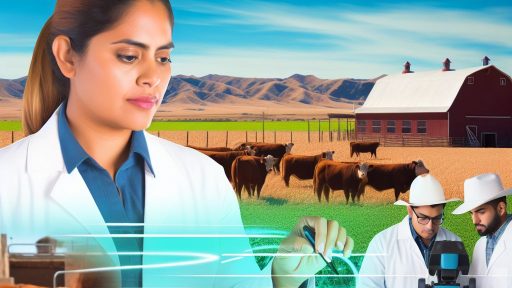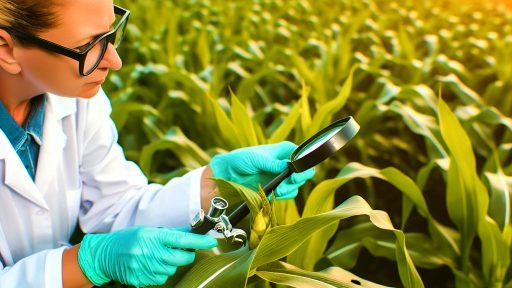Overview of Genetic Engineering Techniques in Agriculture
Defining Genetic Engineering
Genetic engineering involves manipulating an organism’s DNA.
This technique allows scientists to introduce new traits into crops.
For example, researchers can enhance yield or disease resistance.
Common Techniques Used in Crop Improvement
Several methods exist for genetic engineering in agriculture.
- Transgenic technology introduces foreign genes into crops.
- Gene editing employs techniques like CRISPR for precise changes.
- Marker-assisted selection accelerates traditional breeding methods.
The Role of Research Institutions
Research institutions play a crucial role in crop genetic engineering.
They conduct the necessary experiments to develop new varieties.
For instance, the University of California is advancing drought-resistant crops.
Industry Contributions
Agrochemical companies invest in genetic engineering technologies.
They collaborate with researchers to develop improved seed varieties.
CropLife International leads initiatives for sustainable agricultural practices.
Benefits of Genetic Engineering in Agriculture
Genetic engineering offers numerous advantages for crop production.
- Increased resistance to pests and diseases improves crop survival.
- Enhanced nutritional profiles contribute to food security.
- Higher yield potential helps meet the demands of a growing population.
Regulatory Frameworks and Safety Assessments
Safety assessments ensure that genetically engineered crops are safe for consumption.
Regulatory frameworks vary across countries.
In the United States, the USDA and FDA oversee genetic engineering practices.
CRISPR Technology: Revolutionizing Crop Modification
Introduction to CRISPR
CRISPR stands as one of the most groundbreaking innovations in genetic engineering.
Transform Your Agribusiness
Unlock your farm's potential with expert advice tailored to your needs. Get actionable steps that drive real results.
Get StartedThis technology enables precise modification of DNA sequences in living organisms.
Researchers have quickly adopted CRISPR due to its low cost and effectiveness.
How CRISPR Works
CRISPR uses a guide RNA to identify target DNA sequences.
Once located, the Cas9 enzyme cuts the DNA, allowing for changes.
This targeted approach minimizes unintended alterations in the genome.
Applications in Crop Improvement
Farmers benefit from CRISPR by developing crops resistant to pests and diseases.
This technology also allows for the enhancement of nutritional profiles in crops.
Moreover, CRISPR can help create drought-resistant varieties, ensuring food security.
Advantages of CRISPR over Traditional Methods
Traditionally, genetic modification often involved longer and more complicated processes.
In contrast, CRISPR significantly shortens the time required for crop development.
Additionally, it offers higher precision, leading to more reliable results.
Global Impact and Future Prospects
Countries worldwide are increasingly recognizing the potential of CRISPR in agriculture.
Governments and institutions are investing in research to advance this technology.
Furthermore, CRISPR holds promise for tackling climate change-related challenges in farming.
The Role of Genomic Selection in Crop Improvement
Understanding Genomic Selection
Genomic selection has revolutionized the field of crop improvement.
This approach leverages the power of genomic data.
It allows scientists to predict a plant’s value based on its genetic makeup.
As a result, breeders can make more informed decisions.
Advantages of Genomic Selection
Genomic selection offers several benefits to agriculture.
- It increases the efficiency of breeding programs.
- This method reduces the time needed to develop new varieties.
- It improves the accuracy of trait predictions.
Consequently, crops can be tailored more closely to environmental conditions.
Additionally, this technique can target specific traits, such as disease resistance.
Implementation in Crop Breeding Programs
Many research institutions are integrating genomic selection into their breeding programs.
For example, the International Rice Research Institute utilizes this method.
They aim to enhance rice varieties for various environmental challenges.
Showcase Your Farming Business
Publish your professional farming services profile on our blog for a one-time fee of $200 and reach a dedicated audience of farmers and agribusiness owners.
Publish Your ProfileSimilarly, universities across the globe have adopted genomic tools for crop improvement.
These initiatives demonstrate successful applications of genomic selection.
Future Directions
The future of genomic selection looks promising.
Advancements in technology will allow even broader applications.
Increased precision will enable the development of crops adapted to climate change.
Moreover, researchers will continue exploring the genetic basis of complex traits.
Ultimately, genomic selection will play a pivotal role in sustainable agriculture.
Discover More: Data-Driven Decision Making In Agriculture
Development of Disease-Resistant Crop Varieties
Importance of Disease Resistance
Diseases pose significant threats to crop yields worldwide.
Farmers often face crop losses due to various pathogens.
Consequently, developing disease-resistant varieties is critical.
These crops enhance food security and sustainability.
Biotechnology’s Role
Biotechnology plays a pivotal role in crop improvement.
It allows for the precise targeting of genes associated with resistance.
Moreover, researchers utilize techniques like CRISPR for gene editing.
This technology accelerates the breeding of resilient varieties.
Examples of Key Innovations
- Rust-resistant wheat varieties have been developed successfully.
- Incorporating traits from wild relatives enhances resistance.
- Genome sequencing facilitates quicker identification of resistance genes.
These innovations show promise in combating plant diseases.
Collaborative Efforts
Collaboration among scientists, farmers, and governments is essential.
Programs encourage sharing of resources and knowledge.
For instance, the International Rice Research Institute leads successful initiatives.
These efforts help disseminate disease-resistant varieties globally.
Future Directions
Continuous research and investment are necessary for advancements.
Integrating traditional breeding with modern techniques is vital.
Furthermore, education for farmers on these innovations is crucial.
Adoption of disease-resistant crops can revolutionize agriculture.
Uncover the Details: Innovations in Controlled Environment Agriculture for Modern Farms
Enhancing Nutritional Value through Genetic Engineering
Introduction to Nutritional Enhancement
Genetic engineering allows scientists to enhance the nutritional value of crops.
This technology focuses on modifying specific traits to improve health benefits.
For instance, researchers target essential vitamins and minerals in staple crops.
Biofortification Techniques
Biofortification improves nutrient content through traditional breeding and genetic methods.
One widely recognized example is Golden Rice, enriched with Vitamin A.
This initiative aims to reduce deficiencies in developing countries.
Moreover, scientists utilize CRISPR technology for targeted modifications.
CRISPR ensures precision when enhancing nutrient profiles in crops.
Targeted Nutrient Enhancement
Specific nutrients often targeted include iron, zinc, and protein.
Crops such as cassava and legumes undergo modification for increased protein levels.
Furthermore, iron-rich varieties of rice are developed to combat anemia.
Such advancements contribute directly to food security and dietary health.
Environmental and Economic Impacts
Improved nutritional crops can significantly reduce healthcare costs.
They may lower the reliance on supplements and imported foods.
Showcase Your Farming Business
Publish your professional farming services profile on our blog for a one-time fee of $200 and reach a dedicated audience of farmers and agribusiness owners.
Publish Your ProfileIn addition, these crops require less fertilizer, lowering environmental impact.
As a result, farmers benefit economically while promoting sustainability.
Future Directions
Future research will likely focus on multi-nutrient enhancement.
Scientists aim to create crops with numerous benefits to tackle malnutrition.
Collaboration among institutions will drive these innovations forward.
Public acceptance and regulatory frameworks will shape this technology’s future.
Ultimately, enhancing nutritional value in crops holds promise for global health.
Find Out More: Innovations In Automated Machinery For Precision Agriculture

Impact of Synthetic Biology on Sustainable Agriculture
Advancements in Genetic Engineering
Synthetic biology revolutionizes agricultural practices worldwide.
It allows scientists to modify crops with precision and efficiency.
Through this innovation, crops can resist pests and diseases.
This technology also improves nutritional content in crops.
Consequently, farmers can enjoy higher yields and reduced losses.
Enhanced Crop Resilience
One primary benefit of synthetic biology is crop resilience.
Engineered crops withstand environmental stresses effectively.
For instance, drought-resistant varieties thrive under low water conditions.
This adaptation ensures food security in changing climates.
Additionally, heat-resistant crops adapt better to rising temperatures.
Reduction of Chemical Inputs
Another advantage involves reducing chemical inputs in agriculture.
Modified crops can naturally repel pests, minimizing pesticide use.
This approach leads to safer food production practices.
Moreover, less chemical runoff protects nearby ecosystems.
Farmers also benefit from decreased input costs over time.
Promoting Biodiversity
Synthetic biology contributes to promoting biodiversity in agriculture.
Engineered varieties can coexist with traditional crops seamlessly.
This coexistence maintains genetic diversity within crop populations.
Biodiversity enhances ecosystem resilience against pests and diseases.
Ultimately, this leads to a healthier agricultural landscape.
Future Potential and Innovations
The future of synthetic biology in agriculture looks promising.
Researchers continue exploring new avenues for crop enhancement.
Innovations such as genome editing spark significant interest.
This technology offers targeted modifications without foreign DNA.
As a result, public acceptance of modified crops is likely to grow.
Learn More: How Farmers Can Benefit From Blockchain Technology In Supply Chains
Ethical Considerations and Public Perception of GMOs
Understanding Public Opinion
Public perception of GMOs varies significantly around the world.
Many individuals express concerns about food safety.
Others worry about environmental impacts and biodiversity loss.
Surveys reveal that a significant portion of the population prefers non-GMO products.
Media coverage often influences public attitudes towards GMOs.
Conversely, education can improve understanding of genetic engineering benefits.
Showcase Your Farming Business
Publish your professional farming services profile on our blog for a one-time fee of $200 and reach a dedicated audience of farmers and agribusiness owners.
Publish Your ProfileEthical Implications of Genetic Engineering
Ethics play a critical role in the development of GMO crops.
Many argue that altering the genetic makeup of living organisms raises moral questions.
Concerns about potential unforeseen consequences dominate discussions.
Furthermore, issues of corporate control over seeds and farming practices arise.
Opponents question whether large biotech companies prioritize profit over safety.
Regulatory Frameworks
Governments have established regulations for GMO testing and approval.
These frameworks aim to address safety and environmental concerns.
However, regulations can differ significantly between countries.
This inconsistency adds to public confusion and distrust of GMOs.
Transparency in biotechnology processes can help alleviate some fears.
Balancing Benefits and Risks
Proponents of GMOs highlight their potential benefits.
These benefits include increased crop yields and resistance to pests.
Moreover, crops can be engineered for improved nutritional content.
Nonetheless, lasting public trust relies on ongoing research and monitoring.
Balancing the benefits of GMO technology with safety is crucial.
Future Trends in Genetic Engineering for Climate Resilience
Advancements in CRISPR Technology
CRISPR technology offers precise genome editing capabilities.
This innovation allows scientists to modify crops more efficiently.
Researchers are exploring CRISPR for drought-resistant traits.
They also aim to enhance nutrient content in staple crops.
Furthermore, CRISPR can help develop pest-resistant varieties.
Integration of Genomic Selection
Genomic selection streamlines the breeding process significantly.
By analyzing vast genetic data, breeders can make informed choices.
This method accelerates the development of climate-resilient crops.
It is particularly beneficial in identifying desirable traits faster.
Developing varieties tailored to specific environments becomes feasible.
Emphasis on Multi-Trait Modification
Scientists are focusing on modifying multiple traits in crops.
This holistic approach addresses various climate challenges simultaneously.
For example, enhancing drought tolerance and disease resistance together.
Such crops will thrive in increasingly unpredictable weather conditions.
Consequently, farmers can achieve more reliable yields each season.
Collaboration Among Global Researchers
International collaboration fosters innovative solutions in crop engineering.
Researchers from diverse backgrounds share techniques and findings.
This exchange of knowledge accelerates the pace of discovery.
Joint ventures can lead to breakthroughs previously deemed impossible.
Ultimately, global efforts contribute to food security worldwide.
Utilization of Artificial Intelligence
Artificial intelligence enhances data analysis in genetic research.
AI algorithms can predict crop performance under various conditions.
This predictive capability informs breeding strategies effectively.
As a result, researchers can prioritize traits essential for resilience.
Integrating AI into genetic engineering maximizes research efficiency.
Showcase Your Farming Business
Publish your professional farming services profile on our blog for a one-time fee of $200 and reach a dedicated audience of farmers and agribusiness owners.
Publish Your ProfileAdditional Resources
National Program 301 Plant Genetic Resources, Genomics, and …




